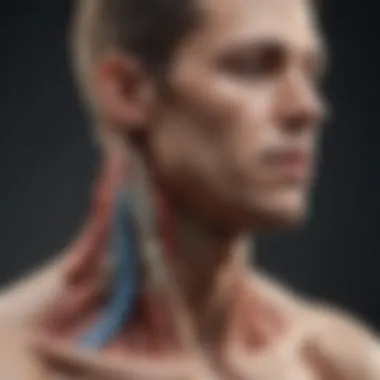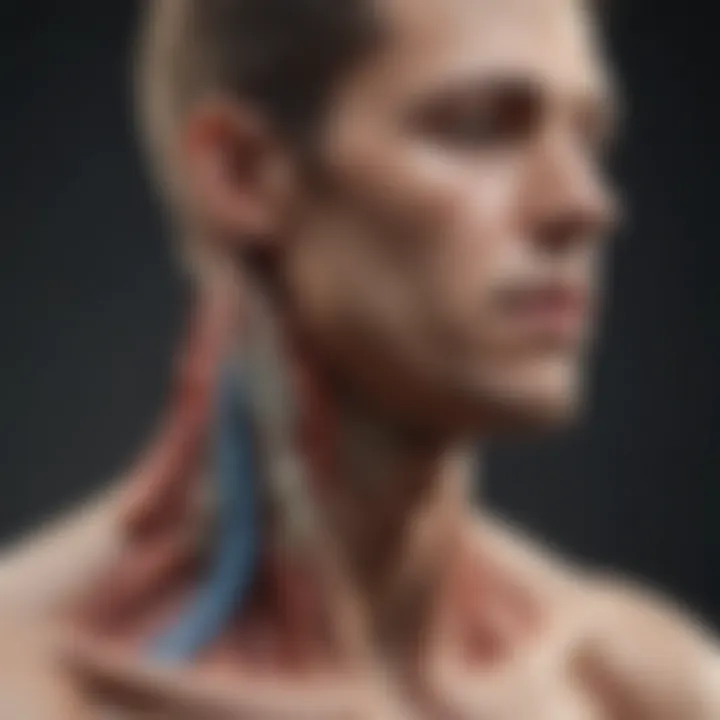Understanding Brace Mechanisms for Posture Correction


Intro
The significance of maintaining proper posture cannot be overstated. Brace mechanisms are increasingly recognized as valuable tools in this endeavor, aiding individuals in correcting their musculoskeletal alignment. This article examines the intricacies of brace design, their functionalities, and their contributions to overall physical health. It seeks to elucidate not only the mechanics but also the physiological perspective of posture improvement through the use of orthopedic braces.
Common causes of poor posture stem from various factors, including habitual behaviors, ergonomic pitfalls, and sedentary lifestyles. As more people confront these challenges, the demand for effective solutions becomes palpable. Braces serve a critical role within this context, by offering support and promoting corrective postural habits. An overview of the types of braces available, their proper usage, and user experiences will guide the reader through the complexities of the topic.
Key Concepts
Definition of Primary Terms
To understand brace mechanisms, it is crucial to define key terms:
- Posture: The position in which someone holds their body while standing, sitting, or lying down.
- Orthotic Devices: Custom or pre-fabricated supports designed to align or improve the function of the musculoskeletal system.
- Brace: A type of orthotic device specifically designed to support or stabilize the spine, neck, or limbs.
Related Concepts and Theories
Braces are grounded in principles of biomechanics and rehabilitative science. The theory of mechanical support suggests that external devices create a more stable environment, reducing strain on muscles and joints. Furthermore, the neuroscience of motor control provides insight into how braces can enhance proprioception, aiding individuals in adopting healthier movement patterns.
Future Directions
Gaps Identified in Current Research
Current literature highlights several gaps in understanding the long-term efficacy of brace usage. While many studies note the immediate effects on posture, comprehensive longitudinal studies are scarce. Questions regarding the psychological impacts of brace adherence and its correlation with lifestyle changes also warrant investigation.
Suggestions for Further Studies
Future research should focus on multidisciplinary approaches that integrate biomechanics, psychology, and physical therapy insights. Additionally, exploring the impact of emerging technologies, such as smart braces that provide real-time feedback, represents a promising avenue for study. Understanding the implications of these innovations could profoundly enhance therapeutic strategies for posture correction.
"Understanding the connection between posture and overall health is essential for both personal well-being and broader public health strategies."
This exploration of brace mechanisms encompasses various aspects crucial not only for students and researchers but also for professionals in related fields. Deepening this understanding can ultimately drive advancements in the design and application of orthotic devices.
Prelude to Posture
Posture is a crucial aspect of human health that often goes overlooked. It involves the alignment of the body, positioning during various activities, and the muscular support that maintains this alignment. Understanding posture is fundamental to grasping how braces work to correct misalignments. Poor posture can lead to numerous health issues, including musculoskeletal pain, reduced flexibility, and impaired mobility. In this discussion, we aim to explore various facets of posture, including its definition, significance, and common issues that arise due to misalignment.
Definition of Posture
Posture is essentially the way a person holds their body. It can be static, such as standing still or sitting, or dynamic, like walking or running. Proper posture involves balanced alignment of bones, muscles, and joints, which allows for efficient movement and minimizes stress on supporting structures. Incorrect posture can be a silent contributor to physical distress, creating a foundation for various health problems.
Importance of Proper Posture
Maintaining proper posture is vital for overall well-being. Correct posture enables more efficient breathing and digestion. It reduces the strain on muscles and ligaments, which can lead to fewer injuries. Proper posture enhances physical performance, making everyday tasks easier and reducing fatigue. Furthermore, it can improve self-esteem and mood, positively impacting mental health. Thus, understanding the importance of posture lays the groundwork for effective intervention methods, such as the use of braces.
Common Postural Misalignments
Misalignments are frequent in daily life. They can develop due to lifestyle habits, ergonomic deficiencies, and inherent physical issues. Below we discuss three common postural misalignments that can be corrected through braces.
Kyphosis
Kyphosis is a condition characterized by an exaggerated forward curvature of the spine, often leading to a hunched back appearance. This misalignment can result from poor posture, degeneration, or conditions like Scheuermann's disease. It contributes significantly to discomfort and can restrict movement, making activities challenging. Understanding kyphosis is critical because it underscores the necessity for corrective measures like braces, which can help realign the spine and improve posture over time.
Swayback
Swayback posture is identified by an excessive backward curve in the lumbar region of the spine, frequently leading to an anterior pelvic tilt. This alignment can strain the lower back and impact overall stability and balance. It brings attention to the need for support, as braces can facilitate a better lumbar positioning and alleviate discomfort. Furthermore, they encourage a more neutral spinal position, ultimately promoting better postural habits.


Scoliosis
Scoliosis is a lateral curvature of the spine that can appear during childhood or adolescence. It varies in severity, and in extreme cases, can lead to physiological complications. Scoliosis influences body symmetry, and thus addressing it is key for both aesthetic and functional reasons. Braces can play a crucial role in managing this condition, as they apply gentle pressure and encourage more optimal spinal alignment, which is essential for long-term musculoskeletal health.
Understanding these common postural misalignments and their implications illustrates the importance of posture correction measures. Through this article, we will further explore how braces function to address these issues effectively.
Causes of Poor Posture
Understanding the causes of poor posture is crucial for implementing effective correction strategies. Poor posture can lead to various musculoskeletal issues, discomfort, and long-term health consequences. By recognizing the underlying factors contributing to poor alignment, individuals can make informed decisions and seek appropriate interventions, such as using braces. This section will discuss the common causes: a sedentary lifestyle, muscle imbalances, and ergonomic deficiencies.
Sedentary Lifestyle
In modern society, a sedentary lifestyle has become increasingly common. Many people spend long hours sitting at desks, engaging with computers and screens. This inactivity can lead to stiff muscles and weakened core strength, both of which negatively impact posture. When people rarely move throughout the day, their bodies may begin to adopt slouched or hunched positions.
The implications of a sedentary lifestyle extend beyond mere discomfort. Research suggests that prolonged sitting can contribute to long-term health issues, including obesity, cardiovascular disease, and diabetes. Hence, it is essential to integrate regular physical activity into daily life. Simple measures such as standing desks or scheduled breaks for physical movement can serve to mitigate the effects of a sedentary lifestyle.
Muscle Imbalances
Muscle imbalances occur when certain muscle groups are stronger or tighter than their opposing counterparts. For instance, when the muscles in the front of the body (like the chest) become too tight while the back muscles weaken, this imbalance can pull the shoulders forward, leading to poor posture. Such imbalances are common in individuals who perform repetitive activities that rely heavily on certain muscle groups without proper counterbalance.
Correcting muscle imbalances often requires a combination of strength training and targeted stretching. A focus on strengthening weaker muscles while stretching tighter ones can lead to improved postural stability. However, individual approaches may differ depending on the specific imbalances present. A professional assessment by a physiotherapist can be beneficial in designing an effective exercise program.
Ergonomic Deficiencies
Ergonomic deficiencies refer to a lack of proper design and arrangement of workplace tools and spaces. Poor workstation setup can lead to awkward body positions, increasing strain on muscles and joints. Key ergonomic factors include monitor height, chair support, and keyboard positioning. When these elements are not aligned with the body's natural posture, the likelihood of developing poor posture increases significantly.
To combat ergonomic deficiencies, individuals should assess their work environments thoroughly. Making simple adjustments can yield significant benefits. For example, ensuring that the computer screen is at eye level, using chairs with appropriate lumbar support, and keeping feet flat on the ground are crucial steps. Employers can also contribute by implementing ergonomic assessments and providing suitable equipment for their employees.
Maintaining proper posture is not solely about aesthetics; it directly influences overall health and well-being.
Understanding these causes is a step towards proactive posture correction. Identifying the specific factors at play can help in seeking appropriate treatments, including the use of braces, while also adopting healthier lifestyles.
Role of Braces in Postural Correction
Braces serve a pivotal role in correcting poor posture. They can provide support that encourages proper alignment of the spine and overall body mechanics. The importance of braces extends not only to aesthetic improvements but also to the significant health benefits they can provide. In physical therapy and rehabilitation contexts, they may act as an essential component of comprehensive treatment plans aimed at addressing various postural issues.
The benefits of using braces include:
- Support: Braces can offer stability to muscles and joints, reducing strain on them.
- Guidance: They help guide the body towards a more neutral position, training muscles to correct misalignments over time.
- Pain Relief: Proper use can alleviate discomfort associated with musculoskeletal imbalances.
- Promoting Healthy Habits: Wearing braces serves as a constant reminder to maintain correct posture, promoting long-term improvements.
However, it's important to note that braces are not a standalone solution. Their efficacy is often increased when combined with targeted exercises and ergonomic adjustments in daily activities.
Clinical Benefits of Using Braces
Braces play a pivotal role in the realm of postural correction, serving as valuable tools for individuals dealing with misalignments and discomfort. Their clinical benefits extend beyond mere aesthetic enhancement; they have the potential to profoundly impact the quality of life for users. Considering the challenges presented by poor posture, it is crucial to analyze how braces contribute to recovery and overall musculoskeletal health.
Immediate Effects
When a brace is applied, the body often experiences immediate benefits. One of the most significant aspects is the improvement of spinal alignment. This can alleviate pressure from specific muscle groups and joints, providing rapid relief from discomfort.
In many cases, users report feeling more conscious of their posture when wearing a brace. This instills a sense of awareness, prompting them to maintain proper alignment throughout daily activities. Common immediate effects include:
- Reduction in Pain: Immediate pain relief is often cited as a primary advantage. By supporting the spine or other affected areas, braces can minimize discomfort.
- Improved Stability: Braces can enhance stability, particularly in individuals with conditions like scoliosis. This added support can lead to better controlled movements.
- Increased Confidence: With improved posture, individuals may experience a boost in self-esteem and confidence.
"Wearing a brace shifted my body awareness. It was surprising how much my posture improved immediately."
— Testimonial from a brace user.


Long-Term Impact
The long-term benefits of brace usage are noteworthy. While immediate effects are essential, the ultimate goal is to foster lasting improvement in posture and related health. Over time, regular use of braces can lead to:
- Muscle Strengthening: By encouraging proper alignment, braces help strengthen core muscles. This is particularly true when users combine brace therapy with exercises specifically aimed at supporting spinal health.
- Prevention of Future Issues: Consistent use may act as a preventive measure against degenerative conditions associated with poor posture, such as disc degeneration.
- Behavioral Change: As users become accustomed to proper alignment, they often find themselves adopting better postural habits even when not wearing the brace. This self-regulation can lead to sustainable improvements in posture over time.
Post-Surgery Applications
Braces are not only useful for non-surgical treatment. They also play a critical role in post-surgical rehabilitation. For individuals recovering from surgeries related to spinal alignment, such as deformity corrections, braces can expedite healing. Some applications include:
- Support During Recovery: Braces provide necessary support for vulnerable areas post-surgery, allowing individuals to move safely without risking further injury.
- Alignment Assurance: Following surgery, braces help maintain proper alignment of the spine, aiding in the recovery of targeted areas. This is crucial for ensuring that surgical interventions are effective and durable.
- Pain Management: Chronic pain can be exacerbated following surgery. Wearing a brace can minimize discomfort during the healing process.
In summary, the clinical benefits of using braces are multifaceted, encompassing immediate relief, long-term health improvements, and essential support in post-surgery scenarios. With the right guidance and commitment to consistent use, braces can significantly enhance the musculoskeletal health of individuals seeking to correct their posture.
Guidelines for Effective Brace Use
The effective use of braces for posture correction is crucial to achieving desired outcomes. Many individuals mistakenly assume that simply wearing a brace will automatically correct their posture. In reality, proper guidance and adherence to specific guidelines are essential to maximize the benefits of these devices. This section explores key factors that influence effective brace use, providing a thorough understanding for students, researchers, educators, and professionals engaged in postural health.
Consultation with Healthcare Professionals
Before beginning the use of any brace, a consultation with a healthcare professional is necessary. This step ensures that an individual's specific posture issues are accurately assessed. Physical therapists, chiropractors, or orthopedic doctors can provide insights into the type of brace most suitable for a person's condition. Seeking professional advice can also help identify if any underlying issues need to be treated concurrently. The information and recommendations from professionals can significantly influence the success of brace therapy and potentially avoid complications associated with improper use.
Duration of Wear
Determining the duration of brace wear is another essential guideline. Different braces come with unique recommendations regarding how long they should be worn each day. For some individuals, the initial phase may require longer wear periods, gradually decreasing as improvement is noticed.
The general rule is to follow the healthcare provider's suggestions closely. Overuse of a brace may lead to muscle weakening or discomfort, while underuse may delay progress in postural correction. Keeping a watchful eye on one's body response to the brace can help gauge the correct balance between wear and break periods.
Combination with Other Therapies
Combining brace use with other therapeutic options can enhance overall effectiveness. Engaging in physical therapy, exercise programs, or ergonomic assessments aids in addressing muscle imbalances that braces alone may not resolve.
Following these guidelines aids in achieving a comprehensive corrective approach:
- Strengthening Exercises: Focus on core strengthening and flexibility to support improved posture.
- Ergonomic Assessments: Reassessing workspace ergonomics can provide a supportive environment for maintaining proper posture.
- Regular Follow-Up: Ongoing assessments with a healthcare professional can help track progress.
Effective brace use is not a stand-alone solution. It requires an integrated approach for successful posture correction.
User Experiences and Testimonials
Importance of User Experiences and Testimonials
User experiences and testimonials play a critical role in understanding the effectiveness of braces for posture correction. Real-life stories provide insights that academic studies might not capture fully. The subjective nature of these experiences can highlight the emotional and psychological impact of wearing a brace, an aspect often overlooked in clinical discussions. Testimonials can serve to empower potential users, allowing them to envision their journey through rehabilitation and improvement.
Patients providing feedback contribute significant data regarding usability and comfort levels of various braces. Additionally, these accounts can guide future users in selecting the most suitable brace for their specific condition. Aspects such as fit, mobility, and level of pain or discomfort are often intricate and personal. Hence, gathering such narratives is essential in shaping understanding and enhancing the overall user experience with these devices.
Case Studies in Postural Rehabilitation
Case studies offer a detailed look into individual journeys of postural rehabilitation. They provide a comprehensive perspective on how braces impact day-to-day life for users. For instance, consider the case of Mark, a 32-year-old office worker with a history of kyphosis. Mark documented his experience over a six-month period while using a thoracic brace. Initially, he reported discomfort and difficulty adjusting to the new device. However, as he persisted, he noticed significant improvements in his posture and reduced back pain. The case study concluded that while initial adaptation may be challenging, perseverance yields substantial benefits.
In another case, Julia, a 45-year-old mother, experienced long-term issues due to a sedentary lifestyle. She utilized a lumbar brace while engaging in both physical therapy and at-home exercises. Observing gradual advancements in her posture, Julia attributed her success to the combined approach of the brace with ongoing physical rehabilitation. These cases underline the importance of individual experiences and how factors such as persistence and support affect the efficacy of brace use.
Patient Feedback on Brace Use
Patient feedback on brace use encompasses a wide range of perspectives. Some individuals express satisfaction regarding the design and support offered by their braces. They often comment on how these devices provide a sense of security, leading to improved confidence in daily activities. For example, one user reported that after wearing a shoulder brace for several weeks, their posture improved noticeably, allowing for more enjoyable participation in group activities.


Conversely, some experiences highlight the downsides of wearing braces. Common concerns include discomfort and the feeling of restriction. Many users mention initial irritation from adjusting to a brace, resulting in reluctance to wear it consistently. Others may experience anxiety about depending on a device for posture correction.
In summary, both positive and negative feedback is essential. It helps prospective users weigh their options and consider potential adjustments for managing discomfort. Understanding these perspectives assists in developing future designs that are more user-centric.
"Personal experiences are often richer than clinical studies when it comes to assessing the reality of brace usage."
This insight underscores the need for continuing research into user experiences to develop effective interventions.
Challenges and Limitations of Brace Use
The discussion surrounding braces for posture correction cannot be complete without addressing the challenges and limitations of their use. While braces can offer significant benefits for individuals striving for better posture, there are also caveats that must be carefully considered. Understanding these limitations provides a more nuanced view of braces and aids users in setting realistic expectations.
Physical Discomfort
Physical discomfort is one of the most common challenges with brace use. Many individuals report feelings of tightness or restrictive movement when wearing posture-bracing devices. This discomfort can vary from mild irritation to significant pain, often resulting from several factors:
- Fit and Sizing: Poorly fitted braces can cause pressure points that lead to discomfort. It is essential for users to seek professional fitting advice to ensure the brace serves its purpose without causing harm.
- Material Sensitivity: Allergic reactions to certain materials used in braces can cause skin irritation. Users with sensitive skin need to consider materials and opt for hypoallergenic alternatives when possible.
- Duration of Wear: Long periods of brace wear can lead to muscle fatigue. Instead of reliance on braces, individuals should incorporate exercises that strengthen supporting muscle groups.
Users should actively communicate any discomfort to their healthcare providers. Adjustments may help alleviate these issues, allowing for a more comfortable experience with the brace.
"The comfort of a brace is crucial for adherence; without comfort, compliance diminishes significantly."
Psychological Barriers
The psychological barriers associated with brace use also warrant attention. Many first-time users of posture braces may experience feelings of self-consciousness or embarrassment. This emotional aspect can influence the willingness to wear a brace consistently:
- Social Stigma: Some individuals may fear judgment from peers for wearing a noticeable corrective device. The perception of being 'different' can lead to reluctance in adopting the brace.
- Mindset and Motivation: The mental commitment to long-term improvement through braces can be challenging. Users must cultivate a positive mindset to view brace use as part of an overall journey toward better health rather than a temporary solution.
- Personal Identity: For some, braces may evoke a sense of loss in personal identity. This is particularly true for athletes or individuals who take pride in their physicality. It is critical to encourage users to focus on the benefits these devices can provide in enhancing overall function.
By understanding and addressing these psychological barriers, healthcare professionals can provide support and resources to enhance a user’s experience with braces.
The Future of Postural Correction Devices
The landscape of postural correction devices is evolving rapidly. It is crucial to understand these advancements within the context of musculoskeletal health and physical well-being. As the prevalence of poor posture increases due to sedentary lifestyles and ergonomic deficiencies, innovative solutions become essential. These solutions not only address existing issues but also enhance overall quality of life. New technologies and designs promise to make braces more effective and user-friendly, influencing their long-term adoption.
Technological Advancements
Technological progress truly shapes the future of posture correction devices. With modern innovations, the functionality of braces is being redefined. Smart braces, equipped with sensors, can provide real-time feedback on postural alignment. This immediate data assists users in making conscious adjustments, supporting better habits over time.
- Wearable Technology: Advanced materials and wearables are becoming more prevalent. For example, lightweight and breathable fabrics allow for longer wear without discomfort.
- Mobile Applications: Many new devices sync with mobile apps to track progress. Users can actively monitor their posture patterns, setting goals and receiving alerts for improvement.
- AI Integration: Artificial Intelligence can predict postural issues by analyzing user data, offering tailored recommendations that improve effectiveness and user confidence.
These advancements highlight a fundamental shift from passive support to active participation in postural correction.
Trends in Orthotic Design
As we look at trends in orthotic design, it is clear that aesthetics and function are merging. Modern users demand devices that are not only functional but also stylish and discreet. Here are several noteworthy trends:
- Minimalistic Designs: Braces are shrinking in size and becoming less obtrusive. This encourages regular use, particularly among individuals concerned about appearance.
- Customizable Options: Some manufacturers now offer customizable braces that cater to individual preferences for fit and comfort.
- Eco-Friendly Materials: A growing emphasis on sustainability is leading to the use of recycled or biodegradable materials in brace production.
These trends signify a larger societal shift toward holistic wellness, merging style with purpose.
Culmination
The discussion surrounding posture correction and the role of braces cannot be understated. A comprehensive understanding of these mechanisms presents vital insights not only for individuals suffering from postural issues but also for practitioners and researchers in the fields of rehabilitation and orthopedic design.
Recap of Key Insights
Posture is integral to maintaining musculoskeletal health. Throughout this article, we examined how poor posture can evolve from various factors, including lifestyle choices and muscle imbalances. Braces are highlighted as crucial tools in mitigating these effects.
Here are the key points summarized:
- Importance of Correct Posture: Proper posture is essential for overall bodily function, affecting everything from breathing to digestion.
- Types of Braces: Each type serves distinct needs, such as thoracic braces for upper back support and lumbar braces for lower back alignment.
- Effectiveness of Braces: Clinical outcomes show that braces can provide immediate relief and contribute to long-term improvements when used appropriately.
- Guidelines for Success: Consultation with healthcare providers ensures that braces are used effectively, complemented by other therapeutic methods when necessary.
- Future Developments: Emerging technologies in brace design suggest a promising future for more tailored and functional postural correction devices.
Final Thoughts on the Importance of Posture
Investing in knowledge about posture and corrective mechanisms is paramount. Both individuals and professionals should recognize that addressing posture is not merely about aesthetics but rather a foundational element of health. As the technology in orthotics continues to advance, it is essential to embrace these changes and apply them thoughtfully to medical and personal health practices, ensuring a holistic approach to well-being.



